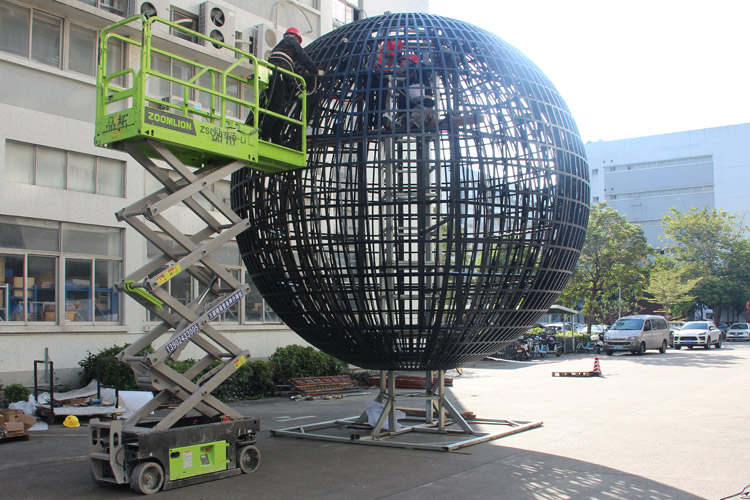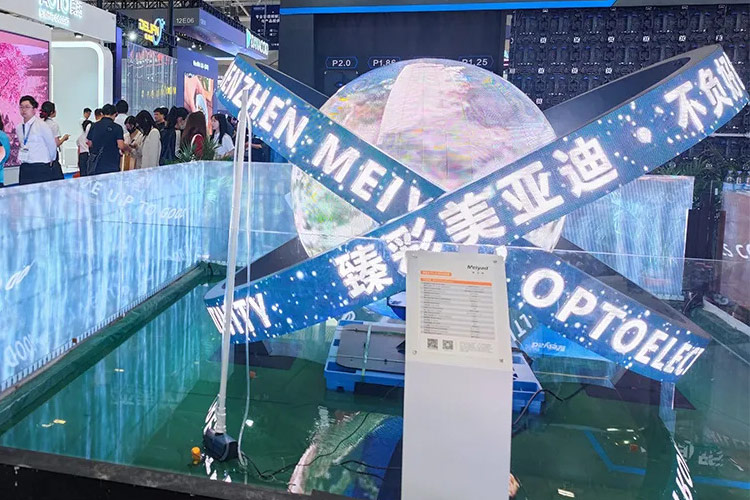+86 135 3053 5995
sales@mydled.comWe use our own and third-party cookies to ensure the proper functioning of the web portal and its complements, perform navigation analysis and show multimedia content. If you continue browsing, you accept the use of this technology. For more information please see our Cookies Policy. Learn more
In today's display technology field, spherical LED screens have become the focus of many applications due to their unique appearance and excellent display effects. Whether in science and technology exhibition halls, large-scale event venues, or commercial centers, they have shown unparalleled charm.
Unique Structural Design
A sphere LED display is a display device that inlays multiple LED lamp beads onto a spherical frame in a specific arrangement. Unlike traditional flat LED displays, its curved surface structure requires more sophisticated design. The frame is typically made of high-strength, lightweight metal materials to ensure the stability and load-bearing capacity of the sphere. At the same time, to achieve seamless splicing, the layout and connection methods of the LED lamp beads have been carefully planned, allowing the entire sphere's surface to present a coherent and smooth image.

Display Principle
Like ordinary LED displays, spherical LED screens are also based on the light-emitting principle of LEDs (light-emitting diodes). After receiving the electrical signal, the LED lamp beads control their luminous intensity and color through the chip. These lamp beads can quickly change their luminous state through efficient grouping and driving circuits, thus enabling the display of images and videos. The key difference is that spherical displays must account for the geometric characteristics of the curved surface, placing higher demands on image mapping and correction algorithms to avoid distortion on the spherical surface.
1. All-round Display
One of the biggest advantage of spherical LED displays is their 360-degree all-around viewing angle. The audience can view the content from any direction—whether it is text, images, or videos—while experiencing a complete and clear visual presentation. This all-around display capability gives spherical LED displays a unique edge in presenting complex three-dimensional models, panoramic videos, and other content.
2. Strong Immersion
Due to their spherical shape, these displays can surround the audience with content, creating a strong sense of immersion. For example, in a planetarium, a spherical display simulating the starry sky can make the audience feel as if they are in the vast universe, greatly enhancing the appeal and impact of the content.

3. Multi-functional Applications
In addition to conventional advertising displays, spherical screens can also be used for purposes such as information dissemination, live event broadcasting, interactive entertainment, and more. This versatility opens up broad application prospects.
1. Commercial Display
In commercial spaces, spherical LED displays can serve as a unique advertising medium. They can be placed in shopping mall atriums, at store entrances, and other high-traffic areas to showcase engaging advertising videos or product content. This helps attract consumers' attention, enhance brand image, and increase product visibility.
2. Events and Performances
In large-scale cultural performances, concerts, sports events, and other activities, spherical LED displays can function as stage backgrounds or on-site decorations. When combined with the performance content, they can create dynamic visual effects, delivering an immersive audiovisual experience to the audience. For example, in some large concerts, the lights and images on the spherical display can change in sync with the rhythm of the music, adding to the atmosphere.

3. Education and Popular Science
In science and technology museums, educational institutions, and other venues focused on education and popular science, spherical LED displays can be used to present scientific principles, historical information, and other content. For example, displaying scientific concepts such as the structure of the Earth and the operation of the solar system can help the audience grasp complex ideas in a more intuitive way.
4. Theme Parks
In theme parks and tourist attractions, spherical displays can be used for information dissemination and interactive entertainment, enriching the experience for visitors.
5. Urban Engineering
In city squares and other public spaces, spherical displays can be used for public service announcements and information dissemination, enhancing the city’s image and promoting public awareness.
1. Curved Image Correction
Due to the spherical geometry, images are prone to stretching and distortion during display. To address this issue, advanced image correction technology is required. By geometrically transforming and compensating for the image, it can be displayed correctly on the spherical surface. These correction algorithms are typically based on complex mathematical models and need to be customized to the specific parameters of the display screen.

2. Heat Dissipation
LED lamp beads generate heat during operation. If heat is not dissipated in time, it can affect the lifespan of the lamp beads and the performance of the display screen. For spherical LED displays, heat dissipation is more challenging due to the relatively enclosed internal space. Therefore, an efficient heat dissipation system, such as a cooling fan or heat sink, is usually incorporated into the display screen. Additionally, materials with good heat dissipation properties are considered during material selection to ensure the display screen maintains stable performance during prolonged operation.
3. Installation and Maintenance
The installation process for a spherical LED screen is far more complex than that of a flat display screen, requiring precise positioning and calibration. During installation, it is essential to ensure the accurate placement of each LED lamp bead and module to achieve optimal display effects. Furthermore, due to its structural characteristics, maintenance work is also more challenging. Maintenance personnel must possess professional skills and tools to troubleshoot and repair faults within the display. To address these challenges, manufacturers typically provide detailed installation and maintenance manuals and offer training for professional technicians.
1. Smaller Pixel Pitch and Higher Resolution
With the continuous advancement of technology, the pixel pitch of LED lamp beads in spherical LED displays will continue to shrink, enabling higher resolution. This will further improve image clarity and detail, allowing the display to meet the demands of high-end application scenarios such as medical simulations and military command.

2. Intelligence and Interaction
Future spherical LED displays will become more intelligent, with features such as automatic brightness adjustment, content adaptation, and more. Additionally, as touch and sensor technologies continue to develop, interactive capabilities will be gradually incorporated into spherical displays. The audience will be able to interact with the content on the display through touch, gestures, and other methods, further enhancing the user experience.
3. Integration with Other Technologies
Spherical LED displays will be deeply integrated with emerging technologies like virtual reality (VR) and augmented reality (AR). For example, in virtual tourism experiences, spherical displays combined with VR technology will allow tourists to immerse themselves in different attractions. In industrial design, the combination of AR technology will enable real-time display and interactive modification of virtual models on spherical displays.
In short, as an advanced display technology, the spherical LED display is showing great potential across various fields due to its unique advantages. Although it still faces some technical challenges, with the continuous advancement of science and technology, it is expected to provide even more impressive visual experiences and greater application value in the future.